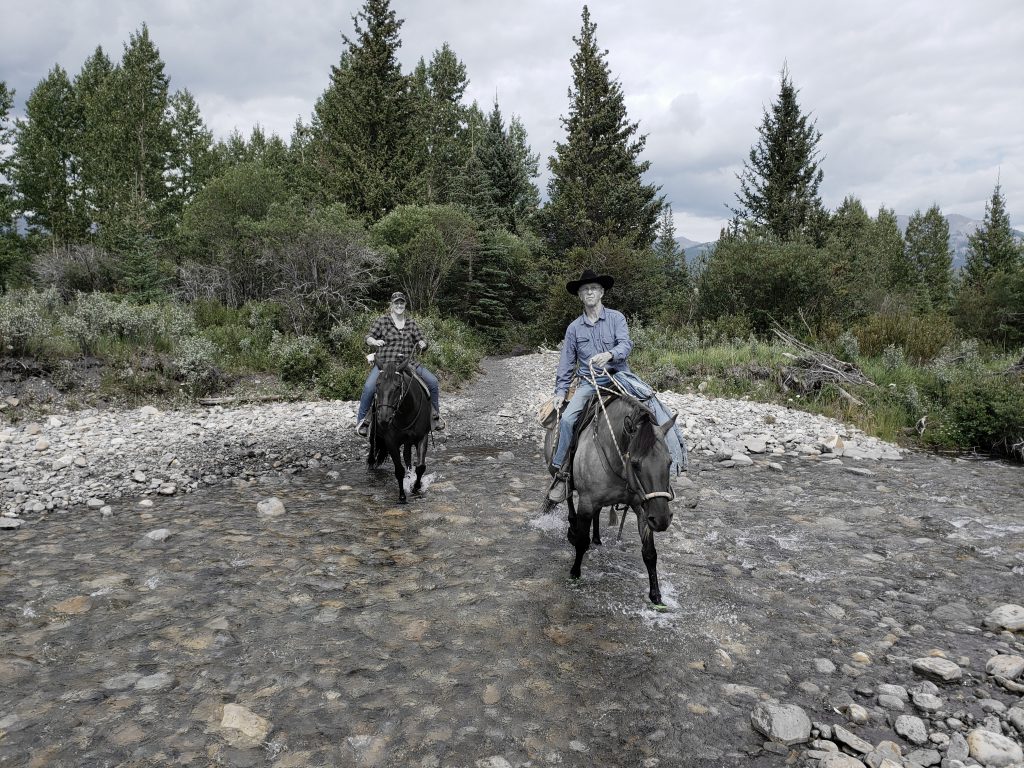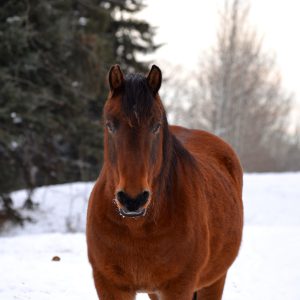Horses have evolved to take in information from the entire space around them, where nature has designed us to have a forward focus. But our eyes and ears function in the same way – we both hear and see with the same anatomical components. Lets look at some similarities and differences, the science behind them and why this is important to us as horsepeople.
In Part 1 of this series, we’re going to investigate the horse’s eyes and vision.
The better to see you with…
Consider for a moment, our own eyes. As a predator, we need to be able to focus on a single point in front of us. A horse, on the other hand, can see almost all the way around itself when facing forward. They don’t have to bend their neck much to cover the blind spot behind them.
The angles below are based on the subject looking forward. We can squeak out a bit more by moving our eyes, which gives us nearly 230° of vision…and the horse a whopping 350°.
| Monocular (what one eye can see) | Binocular (the overlap from both eyes) | Entire Field of View | |||
| Horse | 195° | 80° | 320° | ||
| Human | 155° | 120° | 200° |
In the image below, the green represents what the left eye sees, the red represents what the right eye sees. Where the colors overlap is the binocular vision, and the two combined is the entire field of view.

Although we have wide binocular vision, it is limited. Try reading this when you move your eyes to the left side of this paragraph. You can see the paragraph, but you can’t read it. Our ability to recognize symbols doesn’t extend this far! And although we have peripheral vision, it’s really only helpful in detecting motion or being aware of of objects.
Let’s look at this more specifically. With one eye, a horse can see 195°. In front of them, this vision overlaps about 60-80°. This overlap is called binocular vision, which is important for depth perception, image matching and other factors. A horse has blind spots:
- between the two eyes, right in front of their forehead;
- anything blocked by their nose;
- the width of their head/body behind them.
We also have similar blind spots. We can’t see the space directly in front of our nose, underneath our chin or behind our head. Regardless of the numbers,
A little exercise for you.
Like horses, we have a central overlapping spot in our vision that is seen by both eyes (binocular). To the sides, we see with one eye (monocular) just like a horse does. Try this: open both eyes and look forward. Put your finger in front of your face. Focus on it with both eyes. While keeping your vision forward, move your finger around toward the left side of your head until it almost leaves your vision. At this point, your finger is in your left eye only (monocular). To prove this, just close your left eye. Your finger disappears. Now, while keeping your left eye closed, move your finger back toward the center of your face. Notice the point where your finger comes back into view – that is the limit of your right eye’s monocular space.
Horses have incredibly clear distance vision – an obvious bonus for a prey animal – and can spot motion and image differences at a great distance. We’re not as good at this. Win for the horse!
Are horses color blind? Do they see in only black and white? Well, no one knows exactly what horses see. There are facts that we do know though. Both human and horse eyes have rods and cones. The rods allow us to see hues of grey in low light. The cones allow us to see color under brighter light. This is why colors disappear from our vision gradually as the light level decreases.
Who wins? Well, a horse’s eyes have many more rods than ours do, so they can see much better at night. Have you ever ridden a horse in the dark? You’ll have discovered this advantage. Win for the horse! However, we have a higher cone/rod ratio in our eyes and in addition, we have 3 types of cones: red, green and blue. This allows us to see the variety of colors that we can. Horses only have 2 types of cones: green and blue. This means horses cannot see red, and likely see a washed out version of the rest of the spectrum. Win for us!

Horse vision. 
Human vision.
Above: Horses have dichromatic vision; basically a washed out version of what we see, minus the red. Humans have trichromatic vision, seeing in colors of red, blue and green. Ever look closely at an older TV? You’ll see red, blue and green dots that are used to create all the colors.
Myth Busters
A myth exists that horses cannot see anything in front of behind them. Actually, they can – just like you can – with some small caveats. There is a small cone of space extending from their forehead forward that is a blind spot. This is because their eyes are on the side of their head. This cone becomes infinitesimally small only a short distance in front of the the horse’s face. It’s negligible. Inside of about twenty centimeters, a horse likely can’t focus. That means a horse can see you perfectly well if you stand in front of him. You’ll appear blurry to your horse if you put your head right in front of their eyes. Then again, if humans hold things very close to their eyes, we can’t focus on them either.
Now the common sense part. Horses will move their head to see things their body blocks. If someone was walking a circle around you, and you wanted to keep looking at them, you’d have to turn your head and eventually your body. A horse will do the same but they have an advantage over us: they only need to bend their neck or rotate their head a few degrees to see the entire space around their body.
Let’s also remember that a horse’s eyes are but one of their senses. You would have to be better than the best predatory cat to be able to sneak up on a horse without them knowing. In addition, their hearing is more acute. Just because they’re not looking directly at your face does not mean they’re unaware of you. Horses are also much more spatially sensitive – we all know what it feels like when someone is standing behind us. Well, horses are better at that than us, too!
What is eye contact?
Anatomically, the eye is part of the brain; retinal tissue and brain tissue are considered the same. Due to that, vision can be an overwhelming sense. Whoever said, “The eyes are the window to the brain,” had no idea how accurate they actually were.
You have no doubt heard someone say, “You need to get the horse’s eye!” What they really mean is that you need to get the horse’s focus back on you. It does not necessarily mean that the horse has to look you in the face – that would be really awkward when riding!

That said, there are some circumstances when I do want the horse to be looking right at me. For example, in groundwork when a horse is very frightened, I will stand right in front of them and have them look right at me. This is a very deeply connected form of empathic communication. In that, I can convey peace and confidence.
To explain this, consider a person who is very scared; perhaps they’ve been hurt badly. You look them right in the eyes and say, “Just look at me – its going to be OK.” When we have eyes-to-eyes contact like that, we can affect how another person feels. This is an extremely powerful horsemanship tool when working with frightened horses. We can show them that when their focus is on us, they doesn’t have to worry. What a trust building leadership exercise right there!
In Part 2 of this series, we’ll investigate the horse’s ears and hearing, then put all this knowledge together with a practical purpose.
Scott Phillips
April 2019
